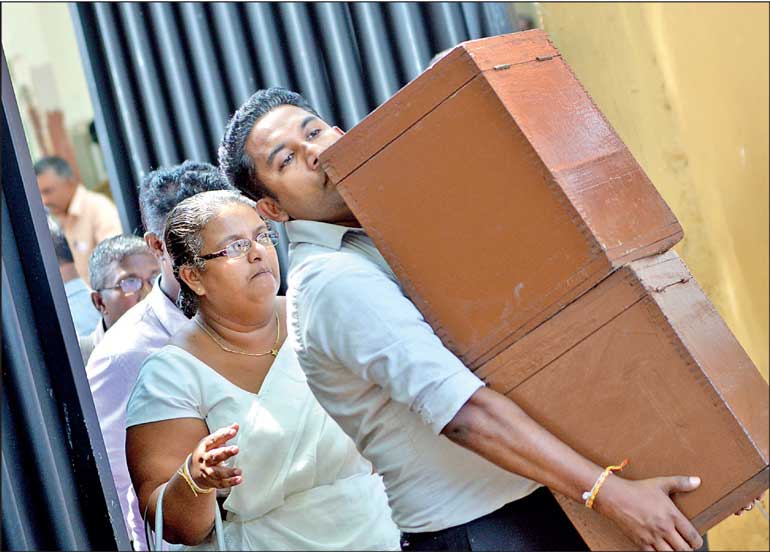Sunday Apr 20, 2025
Sunday Apr 20, 2025
Saturday, 21 September 2024 00:00 - - {{hitsCtrl.values.hits}}

It is time for the JVP to own up to their history and for the Sri Lankan people to make informed, rational choices about their future – Pic by Shehan Gunasekara
 The role of the JVP in Sri Lanka’s political unrest: A historical and analytical perspective
The role of the JVP in Sri Lanka’s political unrest: A historical and analytical perspective
The Janatha Vimukthi Peramuna (JVP), or the People’s Liberation Front, played a pivotal role in the political upheavals in Sri Lanka during the 1970s and late 1980s. Their violent uprisings were born out of discontent with the Government’s handling of the economy and social issues, especially during the reign of Prime Minister Sirimavo Bandaranaike in the 1970s. The extreme measures taken by the JVP in their quest for revolutionary change left a lasting impact on the nation’s political and social fabric.
Their actions, once seen by some as justified rebellion against a corrupt regime, later became a source of deep regret as the movement descended into extremist violence. This essay explores how the JVP ignited communal problems by attacking police stations and targeting civilians, why their actions were initially supported, and why this support later turned into opposition.
The 1970s: Bandaranaike’s socialist experiment
The governance of Sirimavo Bandaranaike in the early 1970s was marked by heavy-handed socialist policies that restricted economic freedom and worsened the quality of life for ordinary citizens. Driven by her belief in a centrally planned economy, Bandaranaike restricted imports, limited the availability of consumer goods, and regulated even basic necessities such as food. Sri Lankans were forced to queue for bread, face shortages of essentials, and live under a system where the type of food they could consume and clothes they could purchase were heavily regulated. The austerity measures she imposed were reflective of her Government’s communist-leaning ideology.
While her Government believed these steps were necessary to alleviate the country’s economic woes, they resulted in widespread dissatisfaction. The elite political class continued to live comfortably while the general populace struggled with food shortages, unemployment, and a lack of basic freedoms. The discontent was palpable, and the JVP capitalised on this anger. Led by Rohana Wijeweera, the JVP saw an opportunity to challenge what they viewed as a corrupt and inept Government. They sought to impose a new socialist order, free from the injustices that had become commonplace under Bandaranaike’s rule.
The 1971 JVP insurrection: From frustration to violence
In 1971, the JVP launched an insurrection aimed at overthrowing the Government. They targeted police stations across the country, believing that attacking the State’s instruments of control would weaken the Government’s hold on power. Their actions were supported by segments of the population who had grown frustrated with Bandaranaike’s restrictions on basic freedoms and the lack of economic opportunities. For a brief period, the JVP was seen as a force of reckoning, challenging the status quo in ways that many felt were long overdue.
However, the uprising was brutally crushed by the Government, and the leaders of the JVP were imprisoned. J.R. Jayewardene, who later became President, imposed long prison sentences on the insurgents. In hindsight, many who initially supported the JVP began to realise the dangerous extremism that underpinned their ideology. The revolutionaries had no clear plan beyond overthrowing the Government, and their violent actions alienated a significant portion of the population. Instead of a constructive solution to the nation’s problems, the JVP’s actions represented a descent into chaos.
The 1988-89 JVP insurrection: Extremism and terror
Despite their initial failure, the JVP would rise again in the late 1980s. This time, their tactics became even more violent and ruthless. The Government of the time, led by President Ranasinghe Premadasa, was already struggling to contain ethnic tensions and the ongoing civil war with the Tamil Tigers (LTTE) in the north and east of the country. The JVP capitalised on this turmoil, launching a second insurrection in 1988-89.
Unlike their first attempt, this uprising was characterised by widespread violence against civilians. The JVP did not only target Government officials but also ordinary citizens who did not follow their strict rules. Postmen, teachers, and other Government employees who defied JVP-imposed curfews were murdered. Educated professionals and intellectuals were similarly targeted, as the JVP viewed them as collaborators with the ruling class. The group’s violent enforcement of its extremist policies led to the deaths of thousands of Sri Lankans during this period.
One particularly egregious action was the JVP’s collection of identification cards from citizens. This practice was designed to control the movements of civilians, creating an atmosphere of terror throughout the country. The Government responded by launching a massive crackdown, and while the JVP’s insurgency was eventually crushed, the scars of their violence remained deeply ingrained in the national psyche.
The JVP today: Denial and political ambitions
Today, the JVP continues to deny its role in the violence of the 1970s and 1980s. Many of the party’s supporters attempt to rewrite history, portraying the JVP as a revolutionary force for good while downplaying or outright denying their role in the murders and terror of the past. This is a critical error in the party’s evolution. For the JVP to truly reform and gain the trust of the Sri Lankan people, they must own up to the atrocities committed during their insurgencies.
Furthermore, the JVP’s current leadership lacks the experience and knowledge necessary to govern a complex and struggling country like Sri Lanka. Their main platform—fighting corruption—is a noble cause, but it is insufficient as a standalone solution to the country’s deep-rooted problems. As demonstrated in a recent economic debate between Anura Kumara Dissanayake’s representative and Harsha de Silva, the JVP is not equipped to offer comprehensive solutions to the country’s economic crisis. Their answers to critical issues remain superficial, often boiling down to vague promises of anti-corruption measures without providing substantive policies on how to stabilise the economy, attract foreign investment, or address the country’s soaring debt.
Voting in anger: The dangers of short-sighted support
The rise of the JVP today mirrors, in some ways, the election of Gotabaya Rajapaksa in 2019. Voters, frustrated with the status quo and seeking vengeance for years of corruption and mismanagement, rallied behind Rajapaksa, believing that he would usher in a new era of strong governance and reform. Instead, his Government plunged the country into economic ruin. The lesson from this episode should be clear: voting in anger, without carefully considering the policies and qualifications of the candidates, leads to disastrous outcomes.
Should the JVP come to power, there is a very real risk that the country will once again descend into chaos. Their lack of a coherent economic plan, combined with their history of violence and extremism, paints a grim picture of what could happen if they were to take control of the Government. Sri Lanka cannot afford another period of instability, and it is imperative that voters approach the upcoming elections with caution and a clear understanding of what each party truly represents.
Finally: The need for accountability and competent leadership
The JVP’s role in Sri Lanka’s history is complex and fraught with contradictions. While they once claimed to stand for the people, their actions led to widespread violence, fear, and the deaths of countless innocent civilians. Today, the JVP’s supporters continue to deny these actions, which is a grave mistake. For any political party to lead Sri Lanka out of its current crisis, they must first acknowledge their past mistakes and demonstrate a genuine commitment to reform.
Moreover, the JVP’s singular focus on corruption, while important, is not enough to address the multifaceted problems facing the country. Sri Lanka needs leaders who understand the intricacies of the global economy, who can foster international partnerships, and who can develop policies that will bring long-term stability and prosperity. Voting in anger, as many did during the election of Gotabaya Rajapaksa, will only lead to further disappointment and chaos.
If the JVP cannot provide clear, actionable solutions to the country’s problems, then they are not fit to govern. The people of Sri Lanka deserve competent leadership, not a return to the extremist ideologies of the past. It is time for the JVP to own up to their history and for the Sri Lankan people to make informed, rational choices about their future.
References:
Somasundaram, Daya. Scarred Communities: Psychosocial Impact of Man-Made and Natural Disasters on Sri Lankan Society. SAGE Publications, 2014.
Gunaratna, Rohan. Sri Lanka: A Lost Revolution? The Inside Story of the JVP. Institute of Fundamental Studies, 1990.
Perera, Jehan. “Sri Lanka’s Revolutionary Legacy: JVP and Its Aftermath.” Daily News, 2014.
(The writer holds a PhD, FRSA, and is President – Virginia Research Institute, USA, and Fulbright Specialist – USA.)
Discover Kapruka, the leading online shopping platform in Sri Lanka, where you can conveniently send Gifts and Flowers to your loved ones for any event including Valentine ’s Day. Explore a wide range of popular Shopping Categories on Kapruka, including Toys, Groceries, Electronics, Birthday Cakes, Fruits, Chocolates, Flower Bouquets, Clothing, Watches, Lingerie, Gift Sets and Jewellery. Also if you’re interested in selling with Kapruka, Partner Central by Kapruka is the best solution to start with. Moreover, through Kapruka Global Shop, you can also enjoy the convenience of purchasing products from renowned platforms like Amazon and eBay and have them delivered to Sri Lanka.
Discover Kapruka, the leading online shopping platform in Sri Lanka, where you can conveniently send Gifts and Flowers to your loved ones for any event including Valentine ’s Day. Explore a wide range of popular Shopping Categories on Kapruka, including Toys, Groceries, Electronics, Birthday Cakes, Fruits, Chocolates, Flower Bouquets, Clothing, Watches, Lingerie, Gift Sets and Jewellery. Also if you’re interested in selling with Kapruka, Partner Central by Kapruka is the best solution to start with. Moreover, through Kapruka Global Shop, you can also enjoy the convenience of purchasing products from renowned platforms like Amazon and eBay and have them delivered to Sri Lanka.